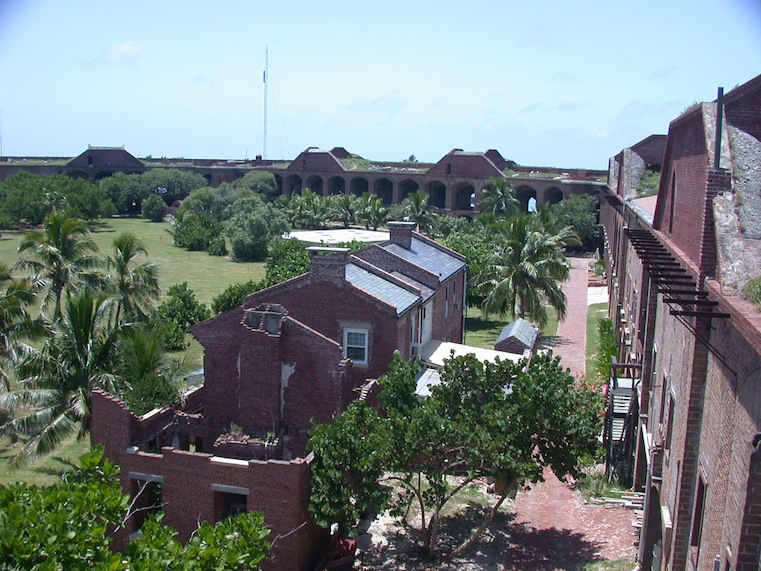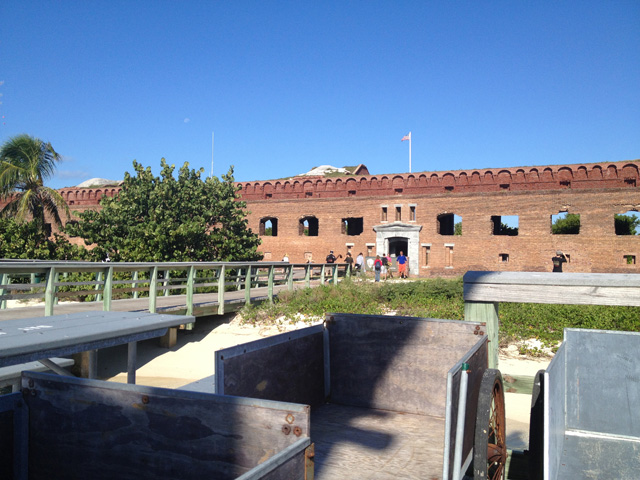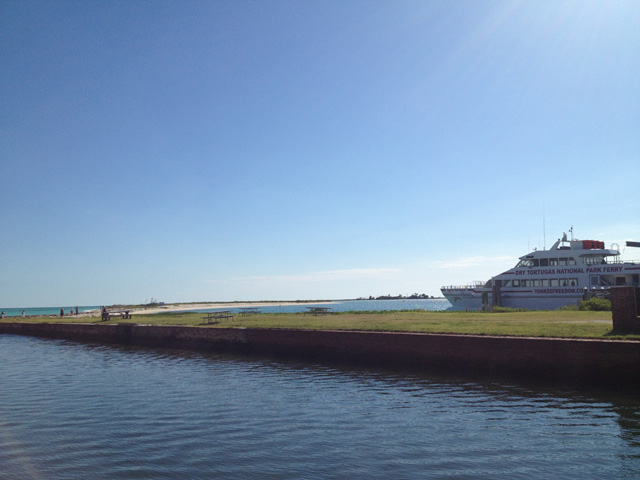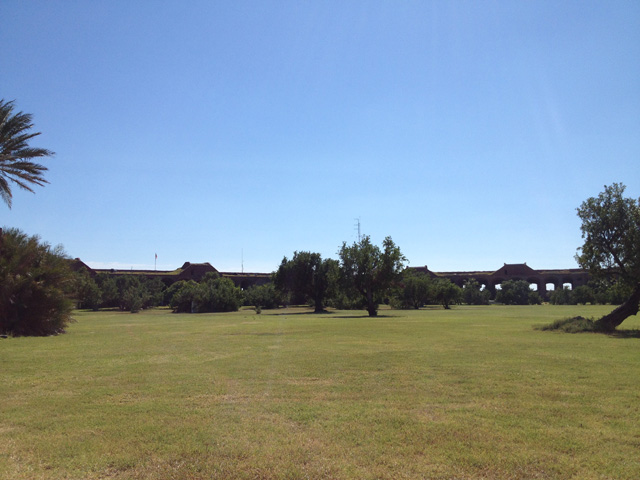
Living in Dry Tortugas can be challenge
DRY TORTUGAS, Fla. – It’s 7 a.m. at Fort Jefferson and Lead Conservator Ron Harvey is starting his day along with three of his team members to work on the treatment of the cannons that have been at the fort for more than 100 years.
Fort Jefferson is located in the Dry Tortugas National Park, which is 70 miles west of Key West. It was built to protect one of the most strategic deep-water anchorages in North America.
 |
The Officers Quarters’ ruins at Fort Jefferson (Photo courtesy by National Park Service). |
The U.S. maintained an important “advance post” for ships traversing the Gulf of Mexico and the Straits of Florida. The port was accessible to ships to resupply, refit or seek refuge from storms.
Within the fort is the Enola crew. These are 15 masons who work and live in the residential and service areas. The crew works for two to three straight weeks and then takes a break for a week.
Harvey and his team have been working at Fort Jefferson since 2005 and they work for about two months out of the year between February-March and October-November.
Life in the fort is tense with 11 to 12 hour days of work depending on the work the cannon needs, but Harvey explained that when the workday is over the fun starts.
| The entrance to Fort Jefferson from the loading dock (Photo by Emma Reyes). |  |
“The great thing about working at the fort is coming back to the Crew’s Quarters, changing into bathing suits and going for a swim, both to cool down and to decompress from the day.”
Harvey also described some of the special activities that he and his fellow living mates do in the fort.
“Often the completion of the day is watching the sunset, go back and make a good dinner, review the day and plan the next day of work. Sometimes we take a moat walk with the sky filled with stars, planets, the Milky Way, and at times a full moon. You never know what you will see in the moat and it is always amazing.”
Living in the Dry Tortugas National Park takes a lot of planning and shopping ahead of time. Harvey explained that when working at Fort Jefferson the project has to be planned in advanced and the materials or equipment needed are scheduled for delivery in a park service boat, the Fort Jefferson, which is anchored in Key West.
 |
At left, the Gulf of Mexico and the Yankee Freedom ferry from the entrance of Fort Jefferson (Photo by Emma Reyes). Below, a View of the open area inside Fort Jefferson (Photo by Emma Reyes). |
“Materials are shipped to the boat, the boat crew receive the materials and load them, transport them and deliver them to the fort ahead of our arrival,” said Harvey.
When Harvey and his team arrive in Key West, they have shopping lists with local available supplies, small items as hardware, hand tools or small things we need as they see fit for the project.
The team must provide its own food for the stay in the fort since there are no shopping facilities in the park. The crew shops for non-perishables and meat that is frozen in Key West. At the end of the shopping day, the team gets the perishables, fresh fruits, vegetables and dairy products that will carry them for the three weeks stay on the island.
In the morning of the departure, all of the materials get packed in banana boxes and taken to the Yankee Freedom to be transported to the Dry Tortugas.
 Because the National Park Service boat, the Fort Jefferson, schedules trips that are twice a month, Harvey and his team make their way to the island on the Yankee Freedom. The ferry makes trips to the park on a daily schedule.
Because the National Park Service boat, the Fort Jefferson, schedules trips that are twice a month, Harvey and his team make their way to the island on the Yankee Freedom. The ferry makes trips to the park on a daily schedule.
When the group arrives at the fort, it unloads the supplies and gear unto a battery operated cart that is then taken to the “Crew’s Quarters” where Harvey and his team make their home for their three weeks work project at the Fort.
Harvey said that he is honored to be working on a project with such history and is grateful for the work the National Park Service has put into saving the fort and its cannon.
“We are so pleased and fortunate to be able to undertake the conservation of the cannon at Fort Jefferson. We are fortunate to be working for one of the very best curators in the park system, Nancy Russell. She has been wonderful to work with and has made this project possible, addressing funding, historical overview and been the balancing element in out approach to the conservation of the important cultural heritage elements at the fort.”
If You Go
- The Dry Tortugas National Park is located 70 miles west of Key West and access is only by private boats, charter boats or seaplane. There is public transportation available, which is called the Yankee Freedom II.
- Yankee Freedom II departs from Key West and the voyage takes about two hours and 10 minutes to get to the park. The ferry offers continental breakfast with fresh fruit, freshly baked bagels, hot and cold cereal, boiled eggs, cheese, yogurt, juice and coffee. The ferry also offers complimentary lunch buffet, which includes fresh deli meats, cheeses peanut butter and jelly for the kids, a variety types of salads, fresh fruit, chips, cookies and soft drinks. The fee for entrance to the park is $5, but it is included in the ferry fee. For more information on rates and travel information visit, http://www.yankeefreedom.com.
- When in the park, explore the historic Fort Jefferson, snorkel the marine resources, bird watching or just sitting and enjoying ocean views. The Yankee Freedom II provides guided tours that are about 40 minutes in duration starting at 11 a.m.
- Experience camping and for a detailed information guide visit, http://www.nps.gov/drto/planyourvisit/camping.htm.

Comments are Closed